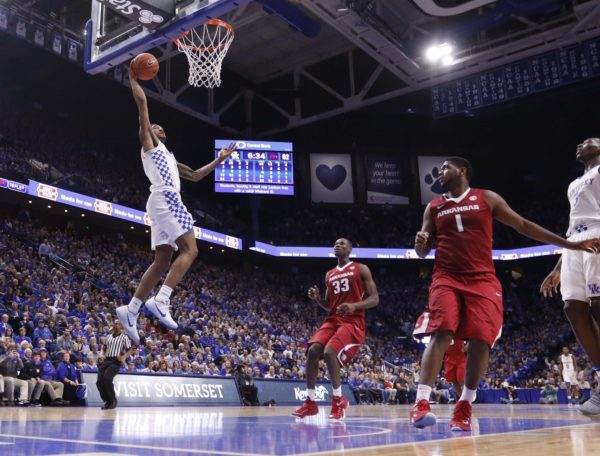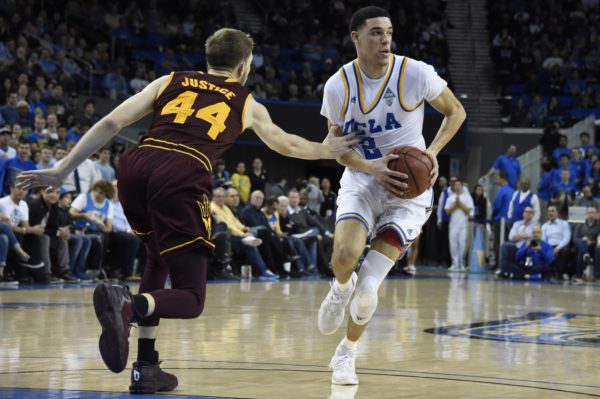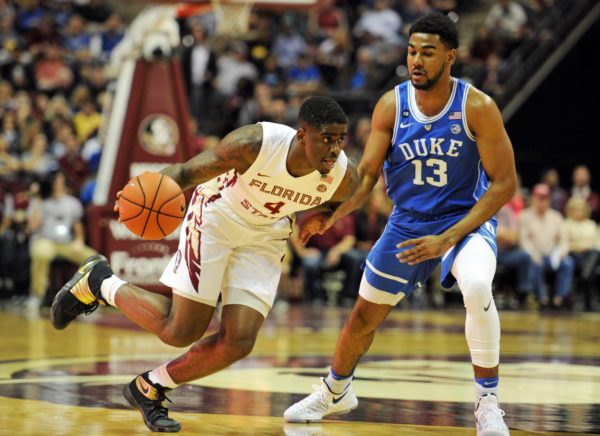UCLA, Kentucky and Florida State Pace This Year’s Trend of Elite Offenses
Posted by Will Ezekowitz on January 20th, 2017Between Malik Monk’s dunks, Lonzo Ball’s passes, West Virginia’s presses and barrages of Creighton’s threes, college basketball feels like it has gotten more exciting this year. Play has definitely gotten faster, as this tweet from Synergy Sports about the rise of transition offense in 2016-17 suggests.
Here's a look at the most prolific transition offenses in the NCAA since '08. This year's Kentucky team is on another level entirely. pic.twitter.com/mut6Fc4TST
— Synergy Sports Tech (@SynergySST) January 11, 2017
This season isn’t necessarily all that much faster — possessions across the sport have only dropped 0.2 seconds per trip (from an average of 17.3 seconds to 17.1 seconds), and transition attempts are only up 0.7% — but that doesn’t mean at the tail end certain teams aren’t playing faster. Let’s take a deeper dive into several of the brand names on their list, with an eye on whether they can keep up their prolific transition offenses through the rest of this season.
Kentucky: 25.7 Transition PPG (all data from hoop-math.com)
- Who They Are: Ranked second nationally in offensive efficiency, these Wildcats might be the most efficient team John Calipari has ever coached. Ranked ninth nationally in tempo, they are definitely the fastest. Kentucky has attempted 38.2 percent of its initial field goals in transition, a mark that ranks fourth in the country and is well higher than its 26.7 percent mark a season ago.
- How They Do It: Kentucky attempts 21.5 percent of its initial field goals in transition after an opponent’s miss, which ranks first nationally. The Wildcats also live at the rim, attempting 54 percent of their transition shots from close range (no rankings exist for this, but it’s very high) and making 75 percent of those attempts. The one questionable area is that they are not very good at shooting in transition, though, with a 29 percent conversion rate on transition threes the lone weakness in a sterling transition game.
- How to Stop It: There have been two blueprints so far: Louisville let the Wildcats get into transition (37 percent of their attempts) but didn’t allow many attempts at the rim. Kentucky responded by shooting 3-of-15 on transition jumpers in a road loss. Vanderbilt eschewed offensive rebounding altogether (grabbing just five for the entire game), electing instead to get back to stop transition (just 28 percent of Kentucky’s field goal attempts) and contesting their shots at the rim (3-of-7). The Wildcats scored just 12 transition points in a narrow victory.
- Will It Continue?: Of Course. For every 12-point transition dud like Kentucky dropped against Vanderbilt, there will be stunning 42-point transition performances like against Ole Miss. The Wildcats will certainly struggle to score as effectively in transition against the better teams they face in March, but they have already proven capable of blowing away most SEC defenses in transition, ensuring that their elite transition game will remain the best in college basketball.
UCLA, 25.0 Transition PPG
- Who They Are: You already know about UCLA’s elite offense, which is ranked first nationally and renders a pedestrian defense practically irrelevant. The Bruins can also get out in transition with the best of them, attempting 34 percent of their initial field goals in transition (13th nationally), and converting often enough to result in a scorching 62 percent effective field goal percentage.
- How They Do It: Like the Wildcats, the Bruins push the ball on misses, with 19.1 percent of their total initial field goal attempts occurring after on opponent’s miss (ninth nationally). But while Kentucky takes it all the way to the rack, UCLA lets it fly from deep. A whopping 49 percent of the Bruins’ transition field goals are threes, and they make those attempts a tidy 37.6 percent of the time. UCLA is also deadly when they get to the rim, though, shooting 80 percent on those attempts.
- How To Stop It: The four teams that have held UCLA to fewer than 1.10 points per possession this year are Western Michigan, Texas A&M, California and Ohio State. The Bruins scored 22.0 transition PPG in those contests but shot just 31.4 percent on their threes in transition. The best defense against this squad may be to protect the rim, let the Bruins fire away in transition, and hope they miss a lot more than they make.
- Will It Continue? Yes, as long as the shots keep falling. This year’s most prolific offense has been just as good in transition in Pac-12 play, averaging just a hair above their season average. The transition three-ball could be an issue, though, and if last Saturday’s 0-of-10 three-pointer transition performance at Utah becomes the norm, look for Steve Alford to excise that inefficiency from an otherwise purring offensive machine.
Florida State, 20.9 Transition PPG
- Who They Are: It’s no coincidence that Leonard Hamilton’s most efficient group in Tallahassee since the days of Al Thornton and Toney Douglas is also his fastest team ever. The Seminoles attempt a paltry 31.9 percent of their initial field goals in transition (just 32nd nationally), but their ruthlessly efficient 62.0 percent eFG in transition (on par with UCLA) more than makes up for it.
- How They Do It: Florida State pushes the pace on misses (13th most initial field goal attempts off of defensive rebounds), but also on steals (42nd nationally), which results in a 70.2% eFG in transition — higher than every other major conference team that steals the ball as often as they do. Once they get out in transition, the Seminoles do their damage almost exclusively at the rim, with 68 percent of their transition points coming there.
- How to Stop It: Florida State’s two losses have come from teams outgunning them, but the two teams that have defended them best — Virginia and Minnesota — did so by limiting their live-ball turnovers and points at the rim in transition. The Cavaliers held the Seminoles to just three attempts at the rim, while the Golden Gophers limited them to just 4-of-10 shooting at the rim in transition, by far their worst performance in that metric this year.
- Will It Continue? Probably. Long considered a defensive guru, Hamilton allowed his athletes to fly more last year en route to becoming the 51st fastest offense in college basketball. Many of those same players have pushed the Seminoles to the top 15 in tempo. ACC play has clipped their wings somewhat as their total has dipped from 21.0 transition PPG to 18.0, but look for the Seminoles to continue running and gunning at every opportunity this year.
BONUS: Mid-major teams playing well in transition that you should know about: UNC-Wilmington, Monmouth, Fort Wayne, Eastern Michigan, Louisiana-Lafayette.












































